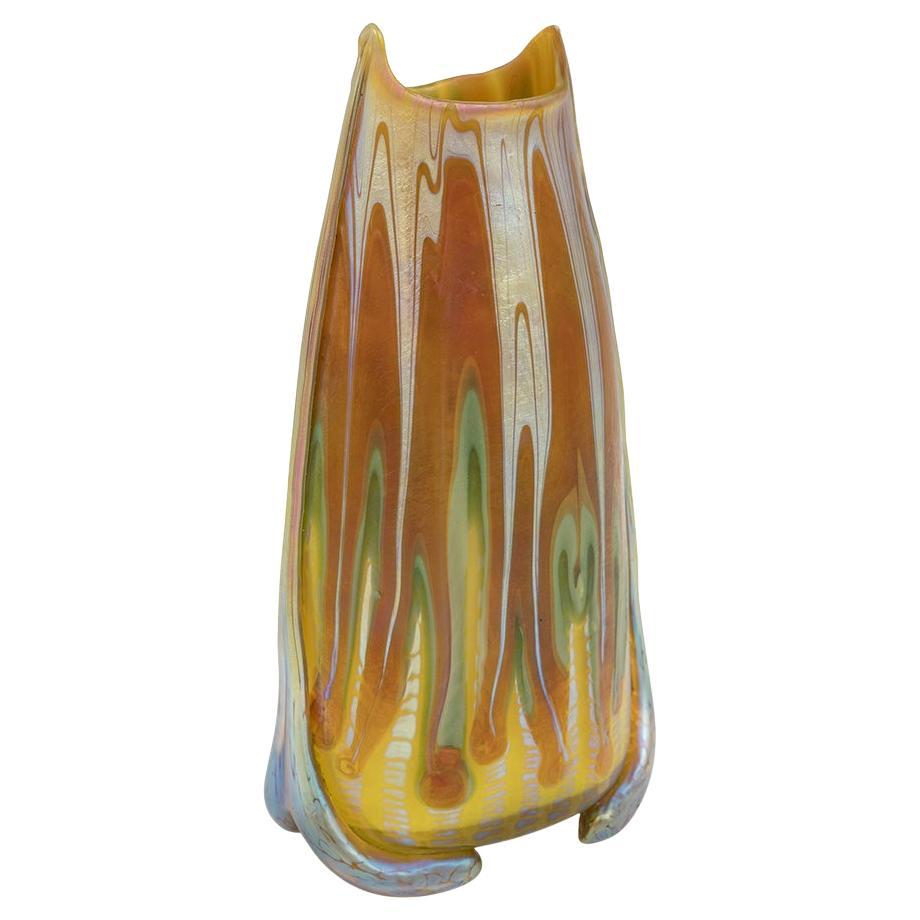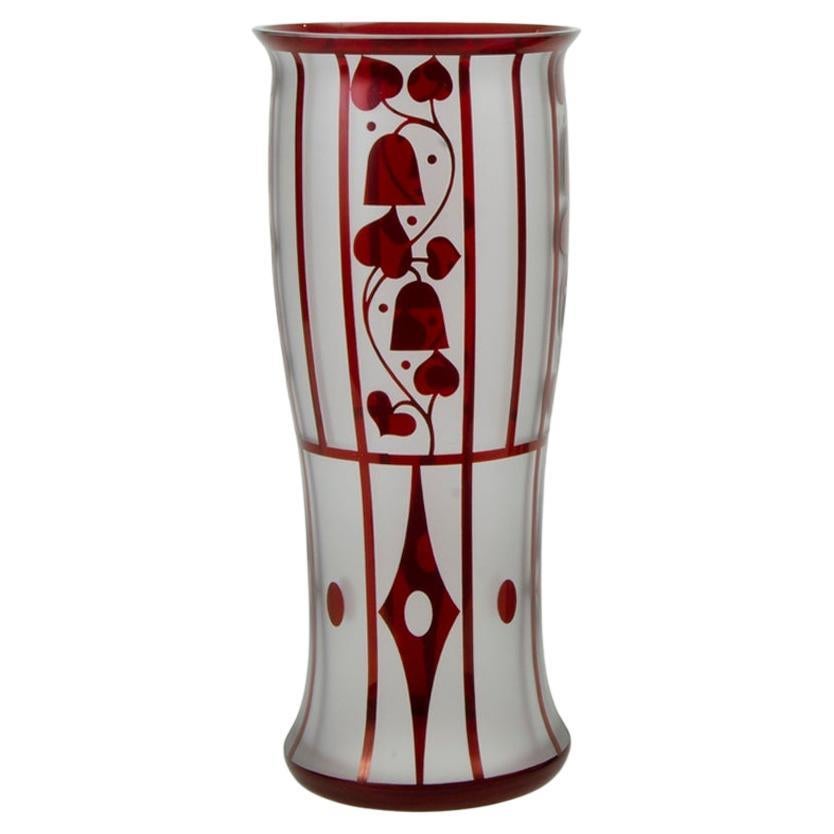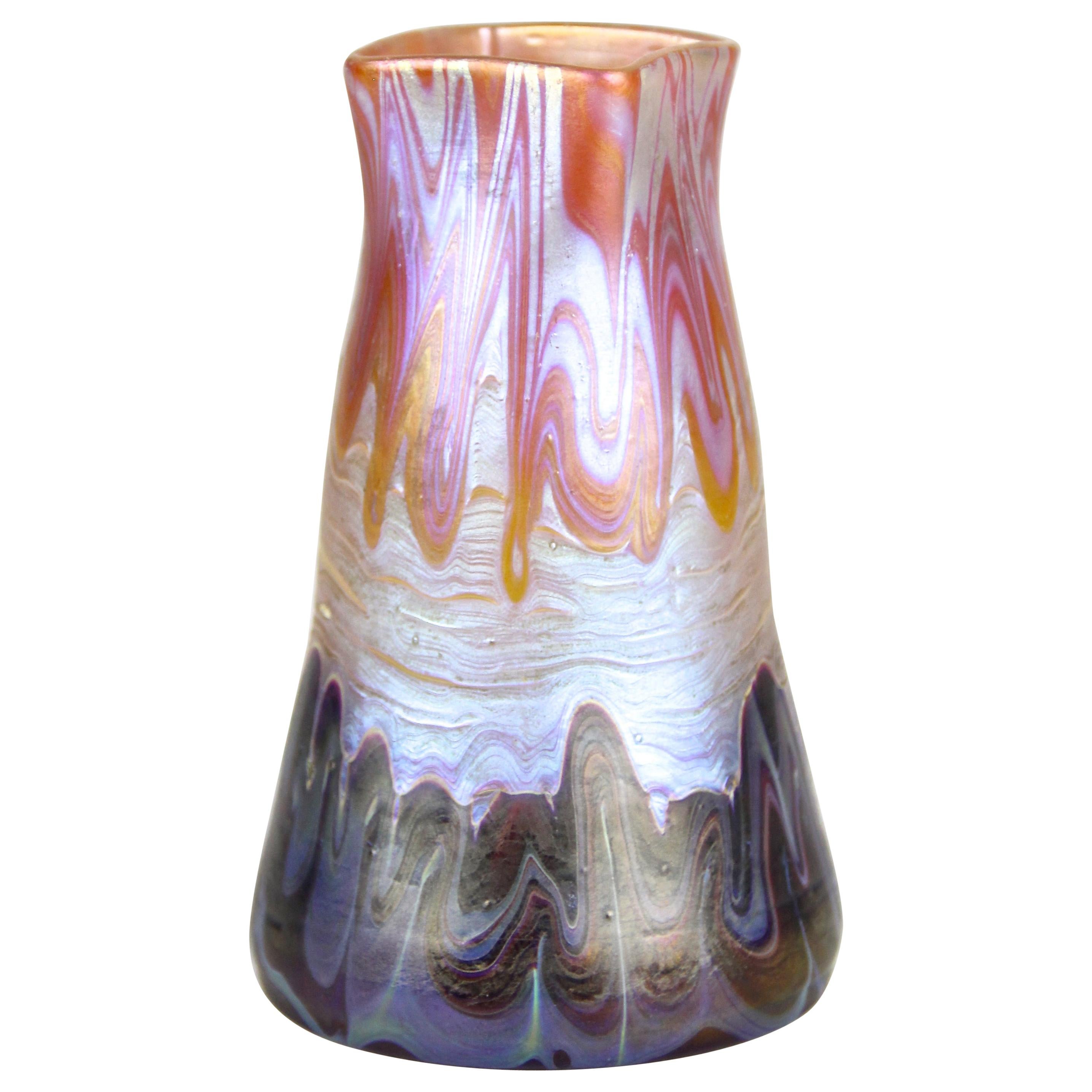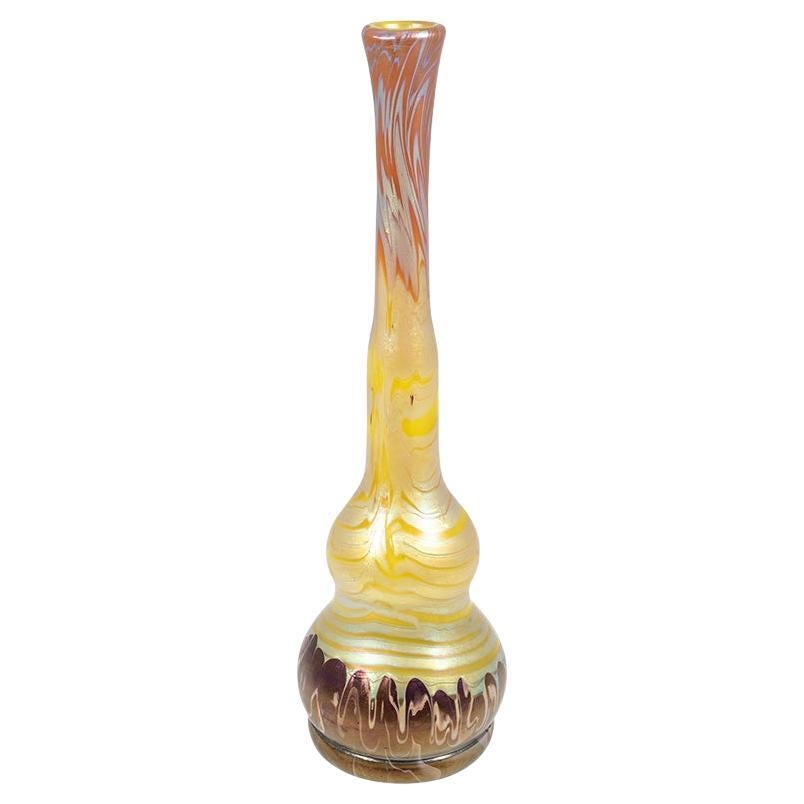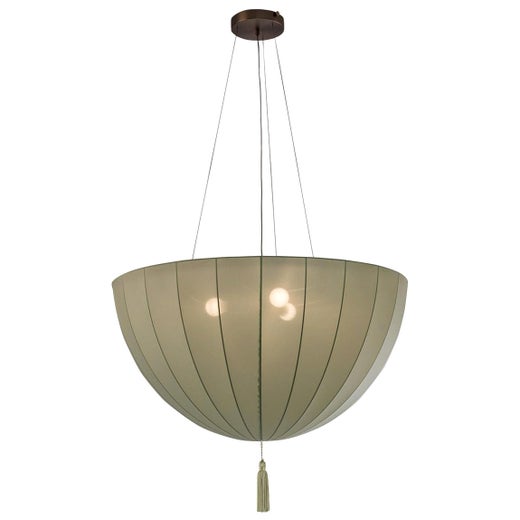Josef Hoffmann Franz Hofstoetter Glass Vase Loetz, circa 1900
About the Item
- Creator:
- Dimensions:Height: 7.49 in (19 cm)Diameter: 4.93 in (12.5 cm)
- Style:Jugendstil (Of the Period)
- Materials and Techniques:
- Place of Origin:
- Period:1900-1909
- Date of Manufacture:1900
- Condition:Wear consistent with age and use.
- Seller Location:Klosterneuburg, AT
- Reference Number:
Josef Hoffmann
The Austrian architect Josef Hoffmann was a central figure in the evolution of modern design, and a leader in an aesthetic movement born in Europe in the late 19th century that rejected florid, extravagant ornamentation in favor of a new emphasis on simplicity of line.
As a founder of the Vienna Secession — a union of artists and designers determined to upend Austria’s artistic conservatism — and later, a founder of the turn-of-the-century Wiener Werkstätte (in English: the Viennese Workshops), a design cooperative that produced superbly crafted furniture and housewares, Hoffmann was a pioneering practitioner of what would become a fundamental principle of modernism: that good design is a way of life.
Hoffmann came of age amidst a shift in the culture of the applied arts, as a conservative order that looked only to the past for inspiration was pushed aside. But what, exactly, would replace that order was in question — and Hoffmann’s career embodies the developing patterns of design’s new spirit. His architectural work reflects his time as a student of the Vienna architect Otto Wagner, who disdained excessive decoration and employed new materials such as steel girders and reinforced concrete to create buildings with airy, open interiors full of light.
As a designer of furniture and interiors, Hoffmann was consistently open-minded about the aesthetics he explored. He was an early adherent of the flowing, organic forms of the Art Nouveau design movement that began to flourish in the late 1880s — but by the opening of the Wiener Werkstätte in 1903, Hoffmann’s designs embraced the beauty of geometry in pieces that feature grids and angular forms.
Hoffmann’s greatest works reflect his ability to combine seemingly conflicting design visions into coherent wholes. His architectural masterpiece, the Stoclet Palace in Brussels, has an exterior that groups together simple geometric forms and spacious interiors marked by subtly naturalistic design details that lend rooms an air of charm and geniality.
Hoffmann’s signature furniture design is an adjustable lounge chair — the Sitzmaschine (1905) — that marries a curving frame with square and rectangular back- and side rests. This piece, like so many others by Hoffmann, reflects a groundbreaking, forward-thinking appreciation for the union of different looks and sources that marks the best of interior design in our own day. Moreover, items offered on 1stDibs — which range from enameled silver jewelry, to silver flower vase baskets and other decorative objects, to sofas, lighting pendants and sconces — testify to the astonishing breadth of Hoffman’s creative pursuits. He was truly a giant of design.
- ShippingRetrieving quote...Ships From: Klosterneuburg, Austria
- Return PolicyA return for this item may be initiated within 14 days of delivery.
- Glass Vase Loetz Franz Hofstötter, circa 1901By Franz Hofstotter, Loetz GlassLocated in Klosterneuburg, ATAustrian Jugendstil glass vase decoration by Franz Hofstötter school of Koloman Moser shape/form by Rudolf Holubetz manufactured by Johann Loetz Witwe circa 1901 Phenomen Genre decor...Category
Early 20th Century Austrian Jugendstil Glass
MaterialsGlass
- Bohemian Glass Vase Loetz PG 358 circa 1900 Art NouveauBy Loetz GlassLocated in Klosterneuburg, ATAustrian Jugendstil glass vase manufactured by Johann Loetz Witwe, Phenomen Genre 358 decoration, circa 1900 This glass vase is an extraordinary example of the Loetz manufactory its...Category
Early 20th Century Austrian Jugendstil Glass
MaterialsGlass
- Bohemian Glass Vase Loetz PG 358 circa 1900 Art NouveauBy Loetz GlassLocated in Klosterneuburg, ATAustrian Jugendstil glass vase manufactured by Johann Loetz Witwe, Phenomen Genre 358 decoration, circa 1901 This glass vase is an extraordinary example of the Loetz manufactory its...Category
Early 20th Century Austrian Jugendstil Glass
MaterialsGlass
- Bohemian Glass Vase Loetz Koloman Moser circa 1900 Blue GreenBy Koloman Moser, Loetz GlassLocated in Klosterneuburg, ATBohemian glass vase, manufactured by Johann Loetz Witwe, Flecken und Streifen decoration, ca. 1900, Green, Blue, Viennese Art Nouveau, Jugendstil, Art Deco, art glass, iridescent gla...Category
Antique Early 1900s Austrian Jugendstil Glass
MaterialsGlass
- Glass Centerpiece Loetz Austrian Jugendstil, circa 1900By Loetz GlassLocated in Klosterneuburg, ATAustrian Jugendstil glass centerpiece with six openings, Johann Loetz Witwe circa 1900 Phenomen Genre 358 decoration This glass centerpieces is an extraordinary example of the Loe...Category
Early 20th Century Austrian Jugendstil Glass
MaterialsGlass
- Bohemian Glass Vase Loetz circa 1900 Pampas Cobalt Art Nouveau BlueBy Loetz GlassLocated in Klosterneuburg, ATBohemian glass vase, manufactured by Johann Loetz Witwe, Pampas Cobalt decoration, ca. 1899, Blue, Silver, Viennese Art Nouveau, Jugendstil, Art Deco, art glass, iridescent glass. T...Category
Early 20th Century Austrian Jugendstil Glass
MaterialsGlass
- Loetz vase Josef Hoffmann, Austria, 1912By Loetz Glass, Josef HoffmannLocated in Autonomous City Buenos Aires, CABAGlass vase, based on a design by Josef Hoffmann, around 1911, manufactured by Loetz Wwe., Klostermühle, around 1911/12, colorless glass, ruby red stained and etched decoration, sli...Category
Vintage 1910s Austrian Art Nouveau Glass
MaterialsGlass, Art Glass
- Loetz Glass Vase PG 358 by Hans Hofstoetter for Paris World Expo, Bohemia, 1900By Johann Lötz Witwe, Franz HofstotterLocated in Lichtenberg, ATAbsolutely rare Loetz Witwe glass vase designed by Hans Hofstoetter for the Paris World Expo in 1900. The vases for the Paris World Exhibition are among the most sought-after pieces ...Category
Early 20th Century Czech Art Nouveau Glass
MaterialsBlown Glass
- Vase Loetz Widow Art Nouveau by Franz Hofstötter, circa 1900By Franz HofstotterLocated in Vienna, ATVase Loetz Widow Klostermuehle Bohemia Art Nouveau. Made by Loetz, Klostermu¨hle, circa 1900. Decor: Phaenomen Genre 358. Designed by: Franz Hofsto¨tter (1871-1958). Franz J. Hofsto¨tter was a German artist who worked at end of 19th century as well as in very early 20th century mainly on behalf of public communities. He created for example configurations and decorations for churches in Germany (church of Holy Heart in Ludwigsthal and church Saint Joseph in Weiden/Oberpfalz). After end of First World War Hofsto¨tter worked only for private clients. The artist had studied in Munich (painting, sculpture and architecture) / Hofsto¨tter worked on behalf of Lo¨tz Manufactory (Boehmia / Klostermu¨hle) in period as from 1896 until 1911, having designed most interesting glass items as well as female portraits made of glass: For this reason he received an accolade from jury of Paris World Exhibition 1900...Category
Antique Early 1900s Austrian Art Nouveau Glass
MaterialsGlass
- Vase Loetz , Style : Art Nouveau , Bohemia, circa 1900By Loetz GlassLocated in Ciudad Autónoma Buenos Aires, CLoetz The glass factory, originally founded in 1836 by Johann Baptist Eisner, was taken over. Loetz was the premier Bohemian glass works during this period. It was located in Klostermühle, near Rejštejn in the Sušice district in South-West Bohemia, which belonged to the Austro-Hungarian Empire until 1918. Susanna Loetz, widow of Glass entrepreneur Johann Loetz in 1852. She renamed the company "Glasfabrik Johann Loetz Witwe", a name that was retained until all activities were stopped in 1947. In 1879 it passed to Max Ritter von Spaun. Under his guidance, together with director Eduard Prochaska, the glassworks flourished as never before and enjoyed its most successful period. Von Spaun and Prochaska concentrated on the development of innovative glass types and new production techniques. Their first successful speciality was a glass type simulating semiprecious stones. It is often called "Marmoriertes Glas" ("marbled glass"). The range contained Onyx (red/brown), Karneol (red/pink) and later Malachit (green). It was introduced in the second half of the 1880's. From the same period dates the Octopus glass, of which the decor resembles the tentacles of a cephalopod. The production of Marmorier-tes Glas was resumed in 1906, in different colours like yellow and white. Octopus, 1885-1890, 1885-1890, unknown, an Malachit, 1885-1890, unknown, The master glass-blowers of Klostermühle had already carried out experiments with iridescence in the first half of the 1890's, and they produced the Olympia, a classically inspired olive green type, in 1896. Similar, in variants of creta green, bronce or Olympia and averse to any redundant decoration was the Glatt decor. It highly contrasted with the more elaborate finishes of that time, but it constitutes a part of the production with a deep sense for taste and quality. Most of the pieces shown in the "Glatt" decors were manufactured for Max Emmanuel in London. The glatt decor remained in use for many years. The Chiné decor had thin glass threads spun around the body in irregular patterns. It is not to be confused with the type of glass that was produced by Kralik. Loetz "Chiné" came in clear, opal, green and pink, Kralik "Chiné" in dark purple. The logical sequel to Chiné was the Pampas decor, green or cobalt blue, in which the threads almost disappeared in the surface, with iridised parts in between. Around the same time the dotted Papillon decor was introduced. The beautiful silver spots were employed on a wide array of models and quite effective on the gooseneck (water sprinkler) and sea shell...Category
Antique Early 1900s Austrian Art Nouveau Glass
MaterialsArt Glass
- Vase Loetz Widow Art Nouveau Phaenomen Gre Silver Overlay, circa 1900By Loetz GlassLocated in Vienna, ATVase Loetz Widow Klostermuehle Bohemia Art Nouveau Made by Loetz, Klostermühle circa 1900 Decor: PHAENOMEN GRE & Gorgeous Silver Overlay This finest Loetz Art Nouveau ...Category
Antique Early 1900s Austrian Art Nouveau Vases
MaterialsSilver
- Loetz Art Nouveau Glass Vase Bronze Phenomenon Genre 29, Austria-Hungary, C 1900By Loetz GlassLocated in Vienna, ATFinest Bohemian Art Nouveau Glass Vase: In shape blown low, cambered body on a large, round floor plan, triple indented wall with a mouth rim formed into a three-pass shape, polished...Category
Antique Early 1900s Austrian Art Nouveau Glass
MaterialsGlass
